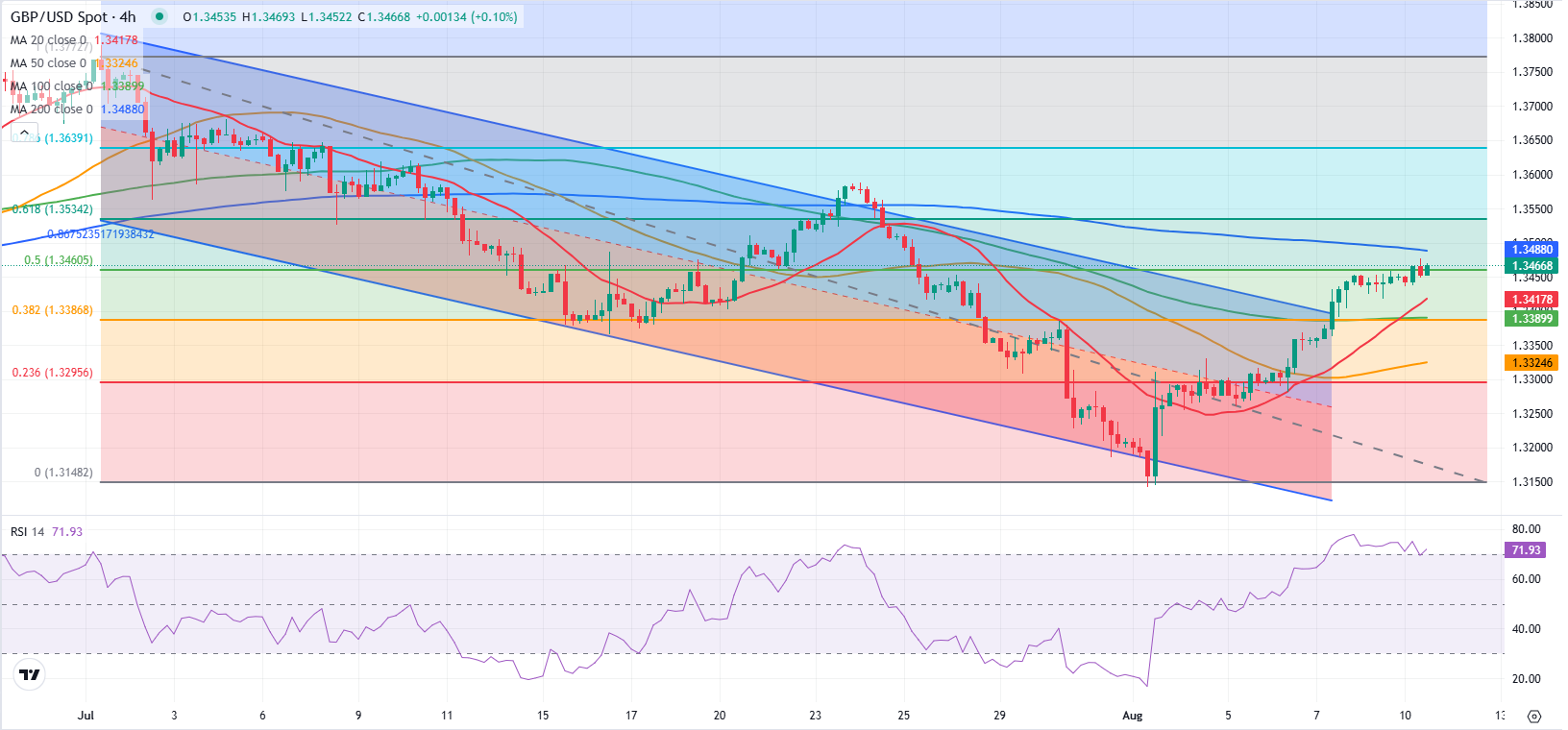
- GBP/USD stays in a consolidation phase below 1.3500 on Monday.
- The risk-positive market atmosphere could support the pair in the near term.
- UK employment data and the US inflation report could trigger big reaction in GBP/USD.
GBP/USD moves sideways above 1.3450 after gaining more than 1% in the previous week. The pair’s technical outlook points to overbought conditions in the near term.
British Pound PRICE Last 7 days
The table below shows the percentage change of British Pound (GBP) against listed major currencies last 7 days. British Pound was the strongest against the Swiss Franc.
| USD | EUR | GBP | JPY | CAD | AUD | NZD | CHF | |
|---|---|---|---|---|---|---|---|---|
| USD | -0.52% | -1.34% | 0.18% | -0.10% | -0.63% | -0.56% | 0.40% | |
| EUR | 0.52% | -0.77% | 0.72% | 0.43% | -0.24% | -0.05% | 0.92% | |
| GBP | 1.34% | 0.77% | 1.53% | 1.22% | 0.53% | 0.73% | 1.70% | |
| JPY | -0.18% | -0.72% | -1.53% | -0.28% | -0.96% | -0.76% | 0.38% | |
| CAD | 0.10% | -0.43% | -1.22% | 0.28% | -0.70% | -0.47% | 0.48% | |
| AUD | 0.63% | 0.24% | -0.53% | 0.96% | 0.70% | 0.20% | 1.18% | |
| NZD | 0.56% | 0.05% | -0.73% | 0.76% | 0.47% | -0.20% | 0.95% | |
| CHF | -0.40% | -0.92% | -1.70% | -0.38% | -0.48% | -1.18% | -0.95% |
The heat map shows percentage changes of major currencies against each other. The base currency is picked from the left column, while the quote currency is picked from the top row. For example, if you pick the British Pound from the left column and move along the horizontal line to the US Dollar, the percentage change displayed in the box will represent GBP (base)/USD (quote).
GBP/USD gathered bullish momentum in the second half of the previous week as Pound Sterling benefited from the Bank of England (BoE) hawkish rate cut. Speaking on the policy outlook, BoE Chief Economist Huw Pill said on Friday that there is a risk of a spill-over into more persistent inflation.
On the flip side, the US Dollar (USD) struggles to stay resilient against its peers as Federal Reserve (Fed) policymakers hint at a dovish policy stance in the last quarter of the year. Fed Governor Michelle Bowman said on Saturday that the latest weak labor market data underscores her concerns about labor market fragility and strengthens her confidence in her own forecast that three interest rate cuts will likely be appropriate this year.
Early Monday, the UK’s FTSE 100 Index gains about 0.3% and US stock index futures marginally higher on the day. In case markets remain risk-positive, especially if the US and China decides to extend the deadline for a trade deal, the USD could have a hard time gathering strength and help GBP/USD hold its ground.
On Tuesday, the UK’s Office for National Statistics will publish the employment data. A noticeable decline in the wage inflation figures could hurt Pound Sterling with the initial reaction. Later in the day, July Consumer Price Index (CPI) data from the US will be watched closely by market participants.
GBP/USD Technical Analysis

The Relative Strength Index (RSI) indicator on the 4-hour chart stays above 70, suggesting that there could be a technical correction before the next leg higher.
On the downside, the immediate support is located at 1.3460 (Fibonacci 50% retracement of the latest downtrend) before 1.3400-1.3390 (round level, static level, 100-period Simple Moving Average (SMA), Fibonacci 382% retracement).
Looking north, a strong resistance level seems to have formed at 1.3490-1.3500 (200-period SMA, static level, round level). In case GBP/USD rises above this area and starts using it as support, 13540 (Fibonacci 61.8% retracement) could be seen as the next resistance level ahead of 1.3600 (static level, round level).
Pound Sterling FAQs
The Pound Sterling (GBP) is the oldest currency in the world (886 AD) and the official currency of the United Kingdom. It is the fourth most traded unit for foreign exchange (FX) in the world, accounting for 12% of all transactions, averaging $630 billion a day, according to 2022 data. Its key trading pairs are GBP/USD, also known as ‘Cable’, which accounts for 11% of FX, GBP/JPY, or the ‘Dragon’ as it is known by traders (3%), and EUR/GBP (2%). The Pound Sterling is issued by the Bank of England (BoE).
The single most important factor influencing the value of the Pound Sterling is monetary policy decided by the Bank of England. The BoE bases its decisions on whether it has achieved its primary goal of “price stability” – a steady inflation rate of around 2%. Its primary tool for achieving this is the adjustment of interest rates. When inflation is too high, the BoE will try to rein it in by raising interest rates, making it more expensive for people and businesses to access credit. This is generally positive for GBP, as higher interest rates make the UK a more attractive place for global investors to park their money. When inflation falls too low it is a sign economic growth is slowing. In this scenario, the BoE will consider lowering interest rates to cheapen credit so businesses will borrow more to invest in growth-generating projects.
Data releases gauge the health of the economy and can impact the value of the Pound Sterling. Indicators such as GDP, Manufacturing and Services PMIs, and employment can all influence the direction of the GBP. A strong economy is good for Sterling. Not only does it attract more foreign investment but it may encourage the BoE to put up interest rates, which will directly strengthen GBP. Otherwise, if economic data is weak, the Pound Sterling is likely to fall.
Another significant data release for the Pound Sterling is the Trade Balance. This indicator measures the difference between what a country earns from its exports and what it spends on imports over a given period. If a country produces highly sought-after exports, its currency will benefit purely from the extra demand created from foreign buyers seeking to purchase these goods. Therefore, a positive net Trade Balance strengthens a currency and vice versa for a negative balance.
Information on these pages contains forward-looking statements that involve risks and uncertainties. Markets and instruments profiled on this page are for informational purposes only and should not in any way come across as a recommendation to buy or sell in these assets. You should do your own thorough research before making any investment decisions. FXStreet does not in any way guarantee that this information is free from mistakes, errors, or material misstatements. It also does not guarantee that this information is of a timely nature. Investing in Open Markets involves a great deal of risk, including the loss of all or a portion of your investment, as well as emotional distress. All risks, losses and costs associated with investing, including total loss of principal, are your responsibility. The views and opinions expressed in this article are those of the authors and do not necessarily reflect the official policy or position of FXStreet nor its advertisers. The author will not be held responsible for information that is found at the end of links posted on this page.
If not otherwise explicitly mentioned in the body of the article, at the time of writing, the author has no position in any stock mentioned in this article and no business relationship with any company mentioned. The author has not received compensation for writing this article, other than from FXStreet.
FXStreet and the author do not provide personalized recommendations. The author makes no representations as to the accuracy, completeness, or suitability of this information. FXStreet and the author will not be liable for any errors, omissions or any losses, injuries or damages arising from this information and its display or use. Errors and omissions excepted.
The author and FXStreet are not registered investment advisors and nothing in this article is intended to be investment advice.








